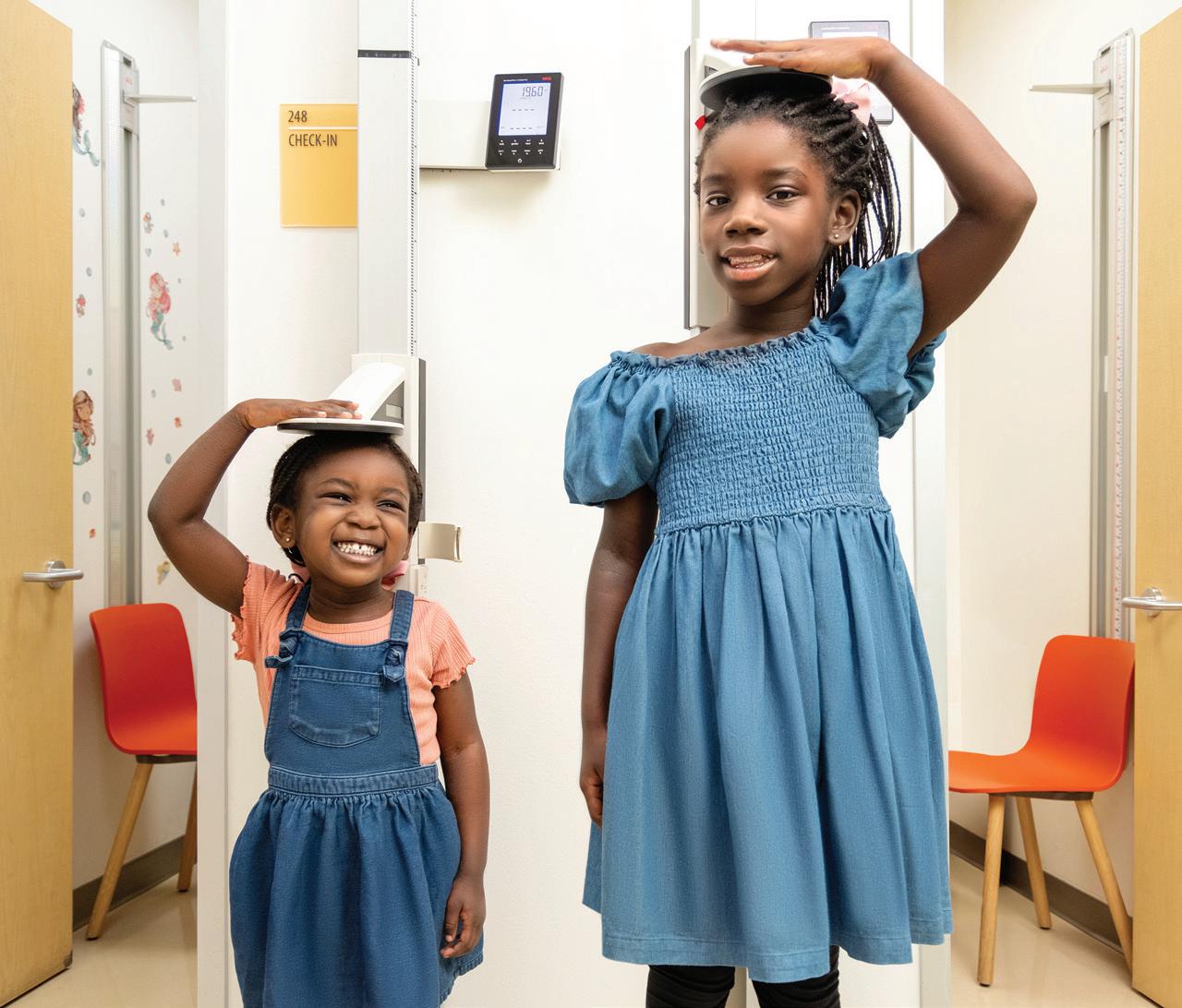
Caring With Open Hearts, Hands, and Minds
Nursing Annual Report 2023


Nursing Annual Report 2023
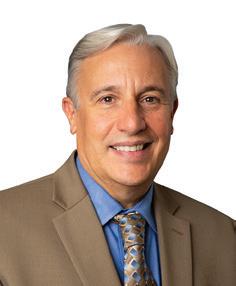
As I reflect on this extraordinary year, I am deeply moved by the exceptional contributions of our nursing team. It is an honor to work alongside such a dedicated group. Their unwavering commitment to our patients and families has been truly inspiring, and I am filled with immense pride for the impact we have made together. Nursing is at the forefront of shaping the future of health care. Their role is crucial and pivotal in fostering an environment where nurses can thrive and make a difference in patient care.
I am thrilled to share that we submitted our application for Magnet® redesignation in August, underscoring our unwavering commitment to top-tier professional nursing practices and superior health care outcomes. Magnet recognition is a testament to the exceptional care we provide, and many of the stories showcased in the annual report were integral to our Magnet application.
As you delve into our annual report, you’ll witness the dedication and innovation exhibited by our nursing team in addressing challenges and enhancing patient experiences through educational development and support programs. The annual report summarizes numerous accomplishments, including the commendable work addressing communication disparities that impact our most vulnerable populations. Throughout this past year, our nurses have led the charge amid ongoing changes and ambitious initiatives aimed at continuous improvement. We have bolstered our shared governance structure through collaborative efforts by integrating new committees and councils. Our obstetrics team has spearheaded the CenteringPregnancy program, a transformative initiative enhancing prenatal care and maternity support and fostering community among our patients. Additionally, you will learn about the expansion of our simulation center.
Looking ahead to 2024, we anticipate exciting prospects and challenges. With our committed leadership and a dedicated team, I am confident that we can achieve our objectives and continue to provide exceptional care to our patients and community.
 Jesus Cepero, PhD, RN, NEA-BC Chief Nursing Officer Senior Vice President of Patient Care Services
Jesus Cepero, PhD, RN, NEA-BC Chief Nursing Officer Senior Vice President of Patient Care Services
The 11-year employee, affectionately known as Ali, said she was humbled and grateful to receive the Grace Award, given to the employee of the year; the Annual Gold Rose Award; and the Nightingale Award for Excellence in Nursing Innovation.
“I was really surprised and very much appreciate it,” said Ali, a day-shift charge nurse in the Pediatric Intensive Care Unit (PICU). “I would not be where I am if it wasn’t for this organization. I owe all my opportunities to Lucile Packard Children’s Hospital Stanford.”
Nursing is a second career for Ali, who started out as a fashion designer but felt unfulfilled and wanted more. “My cup just wasn’t filled,” she shared. She returned to nursing school, receiving a bachelor of science degree in 2015 and completing her master’s degree in 2022. While she was in school full time, she also worked as a patient companion and nursing assistant at Packard Children’s. She is grateful that the organization helped with tuition.
Ali was recognized for her tireless energy and spirit and for helping to shape nursing practices and patient care services. Among the many ways she gives back is by co-chairing the Nurse Executive Council; co-chairing the Health, Engagement, Appreciation, Resiliency, and Teamwork (HEART) Council; and initiating the Heart Carts project, which makes self-care more accessible for nurses by offering comfort measures, resiliency tools, and resources to reduce stress during their shifts.
“In Allison, we find a shining example of dedication, leadership, and a deep commitment to community service,” said Jesus Cepero, PhD, RN, NEA-BC, Senior Vice President of Patient Care Services and Chief Nursing Officer, in presenting the award.
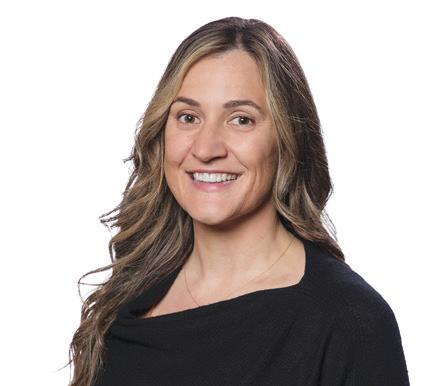
“She embodies the very spirit of the Employee of the Year Award (Grace Award), and we are privileged to celebrate her outstanding contributions. Her journey from a patient companion to a Clinical Nurse IV is an inspiration to us all, and her unwavering dedication to nursing is truly exemplary.”
When she’s not at work, Ali enjoys the outdoors, especially skiing, surfing, trail running, and backpacking with her husband, Ian, and their Australian shepherd, Yeti. “It keeps me balanced, recharged, and motivated,” she said.
As Ali looks back on how far nursing has advanced over the years, she feels satisfaction that nurses have become more valued partners of clinical care teams and are relied on by the interprofessional care team members. “Nurses are the people at the bedside all the time,” she said. “They are the face of the care team. When the clinical team leaves and the family has a question, nurses are the ones they ask. There are many blessings in these moments. To be able to have these experiences is extraordinary.”
More than 200 outstanding nurses at Stanford Medicine Children’s Health were honored during the eighth annual Nightingale Awards for Nursing Excellence.
Named in honor of the iconic Florence Nightingale, this ceremony highlights the remarkable accomplishments of our bedside nurses, inspirational nurse leaders, and dedicated team members who consistently go above and beyond the call of duty. The event recognizes Nightingale and DAISY award honorees, nurses with new certifications or degrees, published nurses, and Professional Nurse Development Program (PNDP) advancements.
2023 Nightingale Award honorees:
• Clinical Excellence—Mini Shibu (NICU)
• Emerging Talent—Laura Becerra (NICU)
• Eminence Award
Lisa Hoyte Loewy (Allergy/Immunology Clinic)
• Excellence in Advocacy—Ann Leung (PCU 300)
• Excellence in Community Outreach— Natasha Rajkumar (CPE&I)
• Excellence in Innovation—Ali Orlandi (PICU)
• Excellence in Mentoring Monica Hom (Neonatal Float Team)
• Excellence in Nursing Leadership— Kristine Taylor (CPE&I)
• Excellence in Precepting—Jay Bundalian (PCU 200)
• Excellence in Quality, Safety, and Improvement— Melissa Seely (Intestinal Rehab Clinic)
• Excellence in Research—Laurel Kent (PCU 500/520)
• Excellence in Teamwork— Acute Care Neuroscience Specialty Care Team
• Friend of Nursing—Renal Patel (Respiratory Care)
• Friend of Nursing—Physician—Anoop Rao (NICU)
• Innovation and Improvement (APP)— Danielle Dawes (OB)
• Preceptor of the Year (APP)— Melissa Ballard (Neurosurgery)
• Rising Star (APP)—Natalie Chin (general surgery)
• Exemplary Clinical Practice Award (APP)— Nirali Thakker (CVICU)
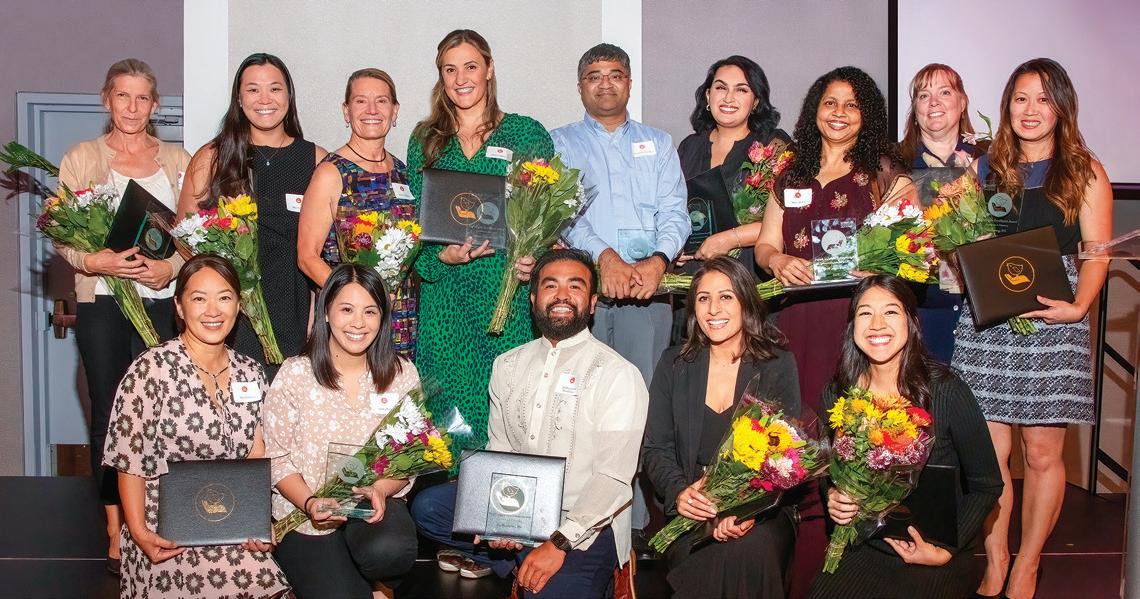




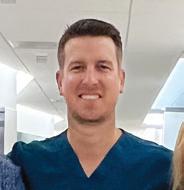
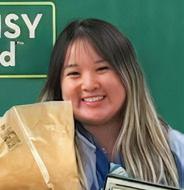



 JoAnne Munoz (CVICU)
Alfy Almario (PCU 200)
William Cole (PICU)
Matt Hendrickson (PCU 360)
Alyssa Abundis (PCU 500)
Tina Nguyen (L&D) Quinton Tran (CVICU)
JoAnne Munoz (CVICU)
Alfy Almario (PCU 200)
William Cole (PICU)
Matt Hendrickson (PCU 360)
Alyssa Abundis (PCU 500)
Tina Nguyen (L&D) Quinton Tran (CVICU)
On Oct. 7, 2023, Raji Koppolu, MSN, MSL, CPNP-PC/AC, NPD-BC, FAAN, achieved a significant milestone by becoming a Fellow of the American Academy of Nursing (AAN), representing 50 years of outstanding leadership in nursing.
Raji is the first AAN Fellow from Stanford Medicine Children’s Health. Her induction is part of the largest-ever class, with 253 nurse leaders from 40 states, the District of Columbia, and 13 countries recognized for their substantial contributions to health care.
The induction ceremony, held in Washington, D.C., as part of the AAN’s 2023 Health Policy Conference, marks a historic moment. Raji Koppolu’s achievements and those of fellow inductees are a testament to their commitment and dedication.


Alyssa Giacalone, PA-C, and Molly Marchand, CCLS, continue to enhance patient care through expansion of the Packard Paws facility dogs program.
The best form of medical care does not always require a prescription or a procedure. A visit from a furry friend can go a long way while in a hospital or outpatient medical setting. Over the years, studies have shown various medical benefits from facility dog services, including normalizing the hospital or clinic environment; motivating individuals to meet their health care goals; and reducing the stress and anxiety that patients experience during hospital admissions, procedures, and clinic visits.
The Stanford Medicine Children’s Health Packard Paws Program was co-founded in 2018 by Advanced Practice Provider (APP) Alyssa Giacalone, PA-C, a physician assistant in the Department of Cardiothoracic Surgery, and Molly Marchand, CCLS, a Certified Child Life Specialist in Perioperative Services. Alyssa saw how her grandmother benefited from animal facilitated therapy (AFT) while in a nursing home, and she became passionate about the idea of starting a program at Stanford Children’s. Alyssa connected with a local service and therapy dog breeder. With the help of a generous donation, Alyssa received Echo, a black Labrador retriever, to help start the Packard Paws Program. Since then, Packard Paws has grown to a team of five dogs who work alongside their handlers.
Packard Paws facility dogs complete extensive formal training to be used to enhance the quality of
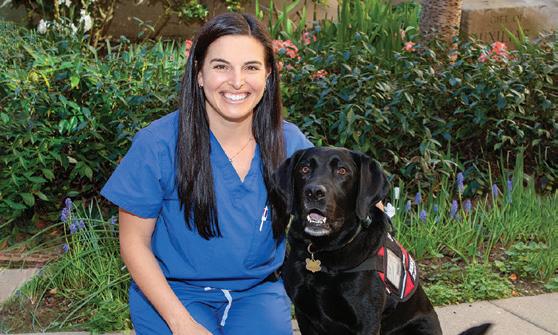
education and services for our patients and families. Our facility dogs are handled by trained staff to encourage goal-oriented interventions with the patients and families of their assigned work areas, as well as provide staff support throughout the hospital.
Packard Paws is made possible through generous contributions from our community members. In 2023, Alyssa and Molly were awarded a grant by the Association of Auxiliaries for Children Endowment to expand the program to allow facility dog services in all areas of the main campus hospital. With continued donor support, they hope to make it possible for each of our facility dogs to make about 50 visits per month.
See page 14 for more information about the Auxiliaries Endowment Fund.
 Raji Koppolu, MSN, MSL, CPNP-PC/AC, NPD-BC, FAAN
Alyssa Giacalone, PA-C, and Echo
Raji Koppolu, MSN, MSL, CPNP-PC/AC, NPD-BC, FAAN
Alyssa Giacalone, PA-C, and Echo
Jesus Cepero, PhD, RN, NEA-BC, Senior Vice President of Patient Care Services and Chief Nursing Officer, shared his goal for an annual Nursing Summit shortly after joining Stanford Medicine Children’s Health. His vision was for an annual event that would bring together nursing leadership from across the organization for a day of collaboration, connection, and learning.
Aug. 1, 2023, saw Dr. Cepero’s vision come to fruition when Stanford Children’s hosted their first-ever Nursing Summit at the Stanford Arrillaga Alumni Center. Over 200 nurses attended the inaugural event, which highlighted the amazing work of our Shared Governance Councils, delved into the future of artificial intelligence (AI) in health care, and provided a much-needed opportunity to reconnect with each other and our nursing vision: caring with open hearts, hands, and minds.

“This annual summit allows our nurses to come together to celebrate our accomplishments, highlight the work of our councils and networks, and, most importantly, have fun together.”
—Jesus Cepero, Chief Nursing Officer

To signify the start of the new fiscal year, the chairs for 13 of the Shared Governance Councils reported out on their work for the previous fiscal year. The new representatives in attendance were able to hear about the intercouncil collaborative work that was done on housewide initiatives, such as peripheral intravenous infiltration and extravasation (PIVIE), and learn more about what to expect of their councils. “This annual summit allows our nurses to come together to celebrate our accomplishments, highlight the work of our councils and networks, and, most importantly, have fun together,” said Dr. Cepero.

The Aug. 1 date was auspicious, as it was also the submission date for the organization’s application for Magnet redesignation. In keeping with the baseball theme of the summit, Dr. Cepero kicked off the event by throwing out the “opening pitch” to submit our Magnet application.
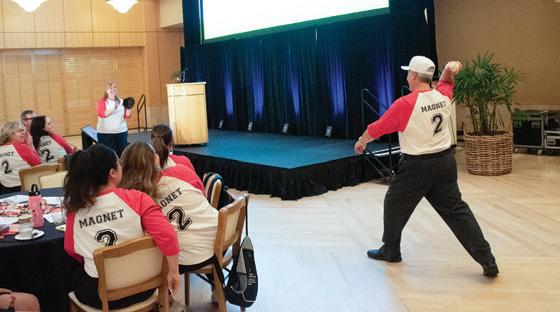
Magnet designation, administered through the American Nurses Credentialing Center, a subsidiary of the American Nurses Association, is one of the most prestigious achievements in health care and signifies an organization’s commitment to creating a culture of nursing excellence. Stanford Medicine Children’s Health achieved their first Magnet designation in 2019. The redesignation application spans more than 2,700 pages, involving more than 150 departments, units, councils, and committees and recognizing more than 600 interprofessional staff. The process for Magnet designation includes a site visit during which the
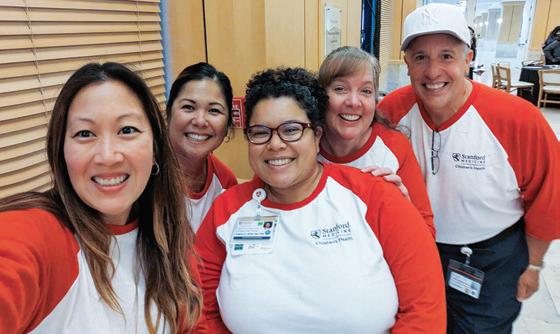

organization will clarify, verify, and amplify the accomplishments highlighted in their application. An overview of the process and what to expect with the site visit was presented to all attendees.
The Nursing Summit provided a forum for nurses to kick off the preparation work for the Magnet site visit with their teams, identify ways they could get their units and departments energized for the site visit, and collaborate with their peers throughout the organization. The teams brainstormed ideas such as hanging poster presentations on the units, Magnet Family Feud and Jeopardy!–style games, and Unit Pride boards highlighting Magnet talking points.
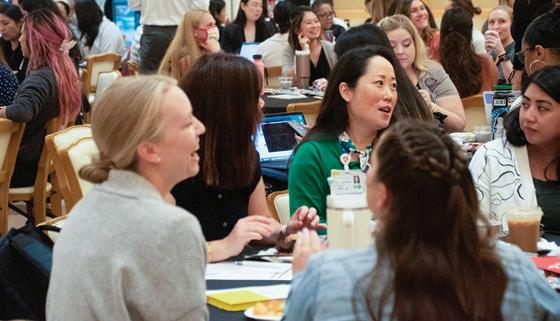
Update: The Magnet site visit occurred Jan. 29–31, 2024, and the organization was informed of their successful redesignation on March 25, 2024.
On Aug. 23, 2023, hundreds of Stanford Medicine Children’s Health staff braved the sweltering heat to attend the 2023 Magnet Professional Fair, held in the Ford Family Garden. The Center for Professional Excellence & Inquiry (CPE&I) hosts this annual event to engage team members from across the organization in understanding how current practices and work relate to our Magnet designation. The event featured 11 booths highlighting a variety of topics,


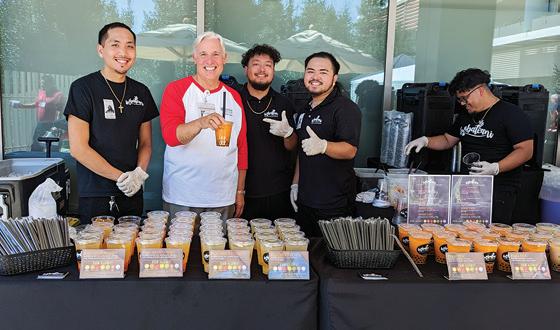
including wellness and ethics, the Palliative Care Program, employee recognition, community service, and hospital outcome data. To accommodate both day- and night-shift workers, the event was open in the early afternoon and again in the evening. Attendees included respiratory therapists, housekeeping staff, security, nurses, physicians, and food service workers. After rounding all the “bases,” attendees could pick up a bubble tea as their reward for participating.
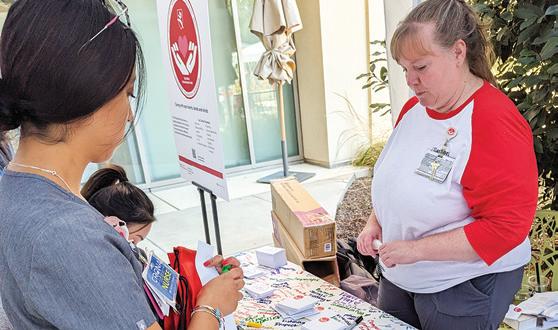

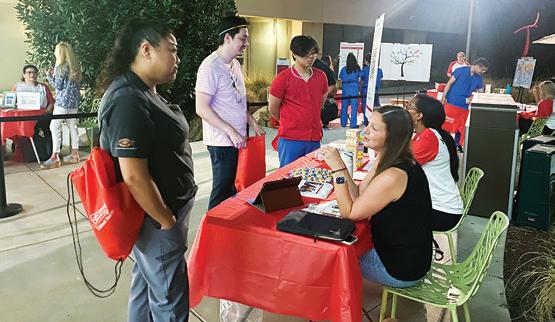
In 2023, the Association of Auxiliaries for Children Endowment awarded $1.1 million in grants to 21 programs. In addition, the Roth Auxiliary—a volunteer group that operates the hospital gift shop and donates all proceeds to Lucile Packard Children’s Hospital Stanford—has funded ImaginAction, the Stanford Nurse Honor Guard program, Heart Carts, holiday meals for families and patients, and holiday stockings for patients, providing an additional $200,000 in program support.
Auxiliaries Endowment Grant Funding for 2023
• Cleft and Craniofacial Department: Auxiliaries Endowed Fund for dental implants
• Interpreter Services: Dedicated interpreter for the Neonatal Intensive Care Unit (NICU) and Badge Buddies
• Amy Huffaker, Child Life and Creative Arts Therapies: Fill My Cup Caregiver Program
• Molly Marchand, Child Life and Creative Arts Therapies: Expand the Paws Program
• Vicki Harrison, Stanford Center for Youth Mental Health and Wellbeing: #GoodforMedia program
• Michael Petersen and Kimberly Browne, Social Services: Care-a-Van
• Kyle Clawson, Stanford Adolescent and Young Adult Cancer (SAYAC): Educational Specialist
• May Wu and Tiffany Tesoro, Pharmacy: Expansion of total parenteral nutrition (TPN) per Pharmacy
• Maricela Olmos, Center for Professional Excellence & Inquiry (CPE&I): Heart Cart refills for frontline clinicians/care providers
• Audrey Moore, NP, NICU: “Just in Time” neonatal resuscitation training bed
• Kristina Rivera, CPE&I: Community Skills Fair for Nurses
• Janet Schauf and Merian VanEijk, Bass Center Outpatient: Oncology Survivorship
• Kaitlin Blamey and Kathleen Steele, Social Services/Bass Center: Wigs for cancer patients
• Kaitlin Blamey and Janet Schauf, Social Sevices/ Bass Center: Bass Center Tea and Card Signing
• Jocelyn Lazaro, PCU 300: Program for resident physicians to shadow nurses
• Andrea Canchola, PCU 200: Discharge Parade
• Ann Leung, CPE&I/PCU 300: Magnet Recharge Chair
• Ashley Frankel, CPE&I/Cardiovascular Intensive Care Unit (CVICU): Cardiology stethoscopes
• Jennifer Granger, Special Care Nursery: UV Box
• Kelly Kirby, NP, Cardiac: Single Ventricle Home Monitoring Program
The Lucile Packard Foundation is the sole fundraising entity for Lucile Packard Children’s Hospital Stanford and the child health programs under the Stanford Medicine Children’s Health umbrella. Through grants, advocacy, and communication, the Foundation promotes a system of care that improves outcomes for children with special health care needs. One arm of funding for the Foundation is the Association of Auxiliaries for Children, which is devoted to ensuring that children in the community receive the medical care they need. They are an integral part of the hospital’s history and have raised millions of dollars and devoted countless hours of service to support the care of children. Each year, the Association reviews dozens of proposals for consideration for the allocation of grant funds through the Auxiliaries Endowment.
Nursing school clinical rotations provide invaluable opportunities for students to gain practical experience in patient care settings. However, with the onset of the pandemic, numerous nursing students faced significant reductions or closures of clinical placements, depriving them of essential hands-on learning. To address this challenge, the Center for Professional Excellence & Inquiry (CPE&I) conceptualized a Community Nursing Skills Fair to support local nursing schools and their students

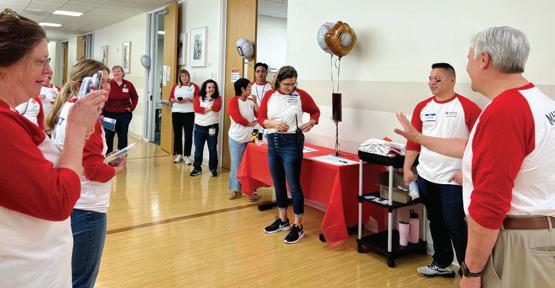
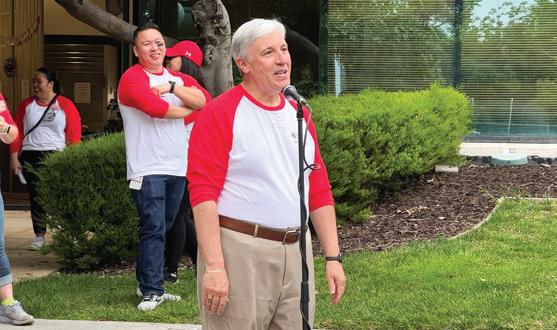
in acquiring vital pediatric and obstetric clinical skills. The April 29 event was facilitated by 23 members of CPE&I, 23 bedside nurses, and three student volunteers. More than 100 nursing students participated in one of two immersive four-hour sessions. Each session included 10 skill stations, and students marked their progress by completing a punch card. In the words of one student, “This was an amazing learning opportunity and a great introduction to the culture at Stanford—thank you!”
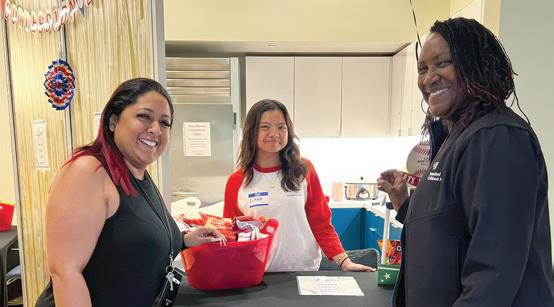
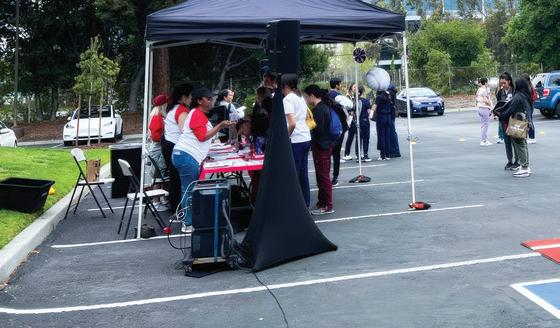
 Check in for the afternoon session.
Pre-event huddle.
Volunteer staff checking in attendees for the morning session. Snack Shack with hot dogs, churros, and nachos for all attendees.
Jesus Cepero, CNO, welcomes attendees. Attendee punch card.
Check in for the afternoon session.
Pre-event huddle.
Volunteer staff checking in attendees for the morning session. Snack Shack with hot dogs, churros, and nachos for all attendees.
Jesus Cepero, CNO, welcomes attendees. Attendee punch card.
When it comes to health care, nurses work tirelessly to ensure the well-being of patients. Recognizing their invaluable contributions is the mission of the Guardians of Compassion—Nurse Honor Guard (NHG) at Stanford Medicine Children’s Health. This group aims to honor nurses in a ceremonial fashion, celebrating their legacy after they have passed away.
While at the 2022 American Nurses Credentialing Center (ANCC) Magnet conference in Philadelphia, Samantha Mourrain, MSc, BSN, RN, listened as a group of nurses from Kaiser Permanente Southern California shared the touching story of their journey in establishing a Nurse Honor Guard. As they recounted their experience, it was clear that Stanford Children’s needed to be a part of this movement. Upon return, Samantha rallied a group of nurses and explored various resources that could provide financial support for this mission. With the Roth Auxiliaries’ generous funding, through the Association of Auxiliaries for Children Endowment Grant, the NHG was able to procure the necessary resources, such as capes, candles, Nightingale lamps, and white roses, to allow the group to arrange meaningful ceremonies that pay tribute to fallen nurses. Nursing is a profession steeped in tradition. Those traditions are used as symbols in the ceremony to reflect honor and respect for those who have served. The NHG takes pride in the honoring of the nurse. They wear traditional nursing uniforms, with white caps and navy capes adorning white nursing dresses. The ceremony incorporates a recital of “The Nightingale Tribute,” and/or “She/He Was There,” by Duane Jaeger, RN. In the “Final Call to Duty,” a ceremonial chime rings out as each member extinguishes a candle, symbolizing the nurse being relieved of their earthly duties. Finally, each member of the honor guard offers a white rose to the family of the deceased nurse before presenting them with the Nightingale lamp.

The NHG at Stanford Children’s currently consists of 12 members (pictured above, from left to right, Lisa Pinner, Natasha Rajkumar, Luanne Smedley, Govinda Shields, Lisa Kohne, Claudia Miller, Ann Leung, Diana Hoffmann, Brooke Kellicut, Linda Ritter, Samantha Mourrain; Ali Orlandi not pictured). They chose the name Guardians of Compassion because it represents the role of the NHG at the service. The entire tribute takes about 10 minutes and can be placed anywhere within the service appropriate to the traditions and beliefs of the recipient’s faith. There is no cost to the family or friends of the deceased nurse for the Nurse Honor Guard service. For the Guardians of Compassion, it is a privilege to serve and participate in this tribute.
For more information on the Guardians of Compassion–Nurse Honor Guard, contact Samantha Mourrain, saalexander@stanfordchildrens.org.
Shared Governance empowers decision-making for health care clinicians related to their practice. This interprofessional structure supports collaboration, leadership development, and communication with a focus on quality and safety. The Stanford Medicine Children’s Health Shared Governance model includes 17 councils and committees, several of which are highlighted here.
Nurse Executive Council
The Nurse Executive Council (NEC) is the governing body for professional nursing practice, providing oversight, leadership development, and direction for the Shared Governance Councils. It also provides review and approval of all nursingrelated policies, approving 174 in fiscal year (FY) 2023. NEC is composed of nurse executives and the chairs of the Shared Governance Councils.
The purpose of the Clinical Practice Council is to be a decision-making body for promoting continuous, consistent, efficient, and effective standards for nursing practice. This council ensures that nurses throughout the organization deliver safe, ethical, and evidence-based nursing care that brings value to patients/families and
Shared Governance Councils
• Nurse Executive Council
• Clinical Practice Council
• Technology and Informatics Council
• Research and Evidence-Based Practice Council
• Health, Engagement, Appreciation, Resiliency, and Teamwork (HEART) Council
• Professional Development Council
• Advanced Practice Provider Council
• Advanced Practice Nursing Specialist Council
nurse practice. The Clinical Practice Council collaborates with other councils to provide input on comprehensive, multiphase projects to improve patient safety, such as peripheral intravenous infiltration and extravasation (PIVIE) reduction.
Technology and Informatics Council (TIC)
The purpose of the Technology and Informatics Council is to be a decision-making body supporting improvements to nursing practice involving technology and informatics. The council ensures that nurses provide efficient and safe care by aligning technology with practice. In FY 2023, the council continued their work supporting Epic upgrades and documentation enhancements; upgrades to Voalte, the organization’s mobile communication system; and the addition of Rover for mobile medication administration.
• Palliative Care Committee
• Nurse Coordinator Council
• Patient/Family Education Council
• Safety Champions Council
• Skin Injury Prevention and Education (SkIPE) Committee
• Safe Medication Practices Committee
• Infection Control Council
• Nurse Operations Council
• Interprofessional Collaborative Council
The Nurse Honor Guard at Stanford Medicine Children’s Health honors fallen nurses.The council also participated in the migration to Kahuna, a new competency management system.
Research and Evidence-Based Practice (REBP) Council
The purpose of the REBP Council is to integrate research and evidence-based practice into clinical and operational processes in nursing and patient care services. This council supports the exploration of safe, ethical, and evidence-based practice for patient care. The council held the 3rd Annual Outstanding With Literature (OWL) Awards during the 2023 Nurses’ Week celebrations, in which 64 nurses were recognized for publications and conference presentations. The group completed two literature reviews and presented their findings to the Clinical Practice Council and REBP Steering Committee. In addition, the council offers an Introduction to EBP Course. In FY 2023, they held three classes with a total of 116 attendees.
Health, Engagement, Appreciation, Resiliency, and Teamwork (HEART) Council
The purpose of the HEART Council is to be the decision-making body promoting health, engagement, appreciation, resiliency, and teamwork within Patient Care Services. The council supports the annual Nightingale Awards Dinner, which recognizes nurses and friends of nursing. In May 2023, the council hosted in-person Nurses’ Week events for the first time since the pandemic, incorporating seven theme days, a Giants game, and nine in-person events. The council also works throughout the year to present the DAISY Award, including monthly individual awards, the DAISY Team Award, and the DAISY Nurse Leader Award.
The PDC supports and provides educational expertise and professional development for all Patient Care Services staff. In FY 2023, the council continued
the previous year’s focus on ongoing competencies, trained 112 new preceptors through the Preceptor Workshop, and held their first Community Skills Fair to support nursing students in developing clinical skills. The council also reassessed their Frontline Leader Workshop, resulting in a program refresh that launched in February 2023. Other council work included data assessment to aid in the education around prevention of falls, central line associated blood stream infections (CLABSIs), and hospital acquired pressure injuries (HAPIs), as well as two A3s to develop standards for precepting and onboarding.
The APP Council meets six times a year to review and discuss professional development, engagement, leadership, and system changes impacting APP standard work. The council coordinated APP Appreciation events to incorporate National APP Week events and awards at the organization, worked on increasing the visibility of APP achievements, and supported APP teambuilding events. The council launched APP Grand Rounds, offering American Academy of Physician Assistants accreditation; hosted a distinguished guest lecturer in February 2023; and held the inaugural APP fellow panel presentation in August 2023. In addition, the council developed and designed the organization’s first APP preceptor workshop and matched 90 students in 2023.
Advanced Practice Nursing Specialist Council
The Advanced Practice Nursing Specialist Council is committed to research and evidence-based practice and to improving patient outcomes. The council has decision-making authority as experts on patient care, nursing practice, and system-wide regulatory requirements for Patient Care Services.
Nurse Coordinator Council
The Nurse (RN) Coordinator Council formulates standardization and is accountable for decisions
that affect the RN Coordinator (RNC) role. The council is the primary source for disseminating RNC changes and best practices. Throughout FY 2023, the RN Coordinator Council focused on standardizing documentation, nursing competencies, and mentoring projects. The members reviewed the RNC Survey and revisited the Nursing Way.
The Patient/Family Education Council partners with a multidisciplinary team of experts to provide vision and guidance for innovations in health literacy and patient and family education. The council uses evidence-based, health literacy best practices in all processes. The members disseminate information on new education materials to the hospital community. FY 2023 was a busy year for the council. They held three collaborative summits with Family Centered Care parent mentors to work on PIVIE, pain education, and gastrostomy tube (GT) education; assisted with the launch of InJoy health education throughout the Johnson Center for Pregnancy and Newborn Services; and coordinated a photo shoot with Marketing to add more than 500 photos to the general image library. In addition, the council continued to offer their Introduction to Health Literacy course, holding three classes and reaching 125 attendees in FY 2023.
The Safety Champions Council consists of clinical and nonclinical frontline staff who are passionate about safety, who role-model safety behaviors, and who coach others on error-prevention strategies to foster an interdisciplinary collaborative approach to promoting a culture of safety. The council selects new Mission Zero Hero winners every month, recognizing staff throughout the organization who demonstrate the Mission Zero Error Prevention Strategies in their work. In FY 2023, the council
implemented a new Safety Champs onboarding program designed to equip new members with the necessary knowledge and skills to effectively contribute to the organization’s safety initiatives. In addition, members of the council collaborated on various improvements, including root cause analyses (RCAs) for serious safety events (SSEs) and a rapid process improvement (RPI) evaluating measurement and documentation of clinical weights.
The SkIPE Committee focuses on role-modeling excellent skin care, providing expert consultation and recommendations for prevention and management of skin issues, and presenting evidence-based education to peers to prevent skin injuries. The committee completed four pressure injury prevalence studies in FY 2023. These prevalence studies involve completing a head-to-toe skin assessment on all admitted patients on a given day to assess for the presence of pressure injuries. The committee worked with the Technology and Informatics Council (TIC) to improve and update the hospital acquired pressure injury (HAPI) bundle to reduce charting burden, increasing HAPI bundle compliance up to 56% and extending the longest streak between reportable HAPIs to 90 days. The committee also assisted with the Two RN Skin Assessment pilot, which involves using two RNs to conduct an initial skin assessment on all admissions and transfers.
The Safe Medication Practices Committee serves as a forum to address issues related to medication safety. The members review adverse drug events and compliance with accreditation and regulatory agencies as related to medication safety. The members act as nurse liaisons between the committee and the units.
The IC Council evaluates evidence and reviews policies to improve infection prevention methods. The council identifies and escalates infection prevention and control issues to the Infection Prevention and Control (IPC) department, provides ongoing education and coaching to staff on IPC topics, and serves as a resource for staff and patients.
within management responsibility and align strategic priorities with resources.
Interprofessional Collaborative Council
The Interprofessional Collaborative Council aims to promote a culture of mutual respect among disciplines, provide a forum for interprofessional problem-solving, and enhance collaboration between frontline providers (physicians, nurses, and advanced practice providers). The council worked throughout the year to launch their grantfunded Resident-Nurse Buddy Program. The initial offering matched 39 residents and nurses from PCU 300, 360, 400, and Vascular Access. Shared Governance … continued from page 19
The Nurse Operations Council is the decisionmaking body for standardized leadership practice. They set policy and direction
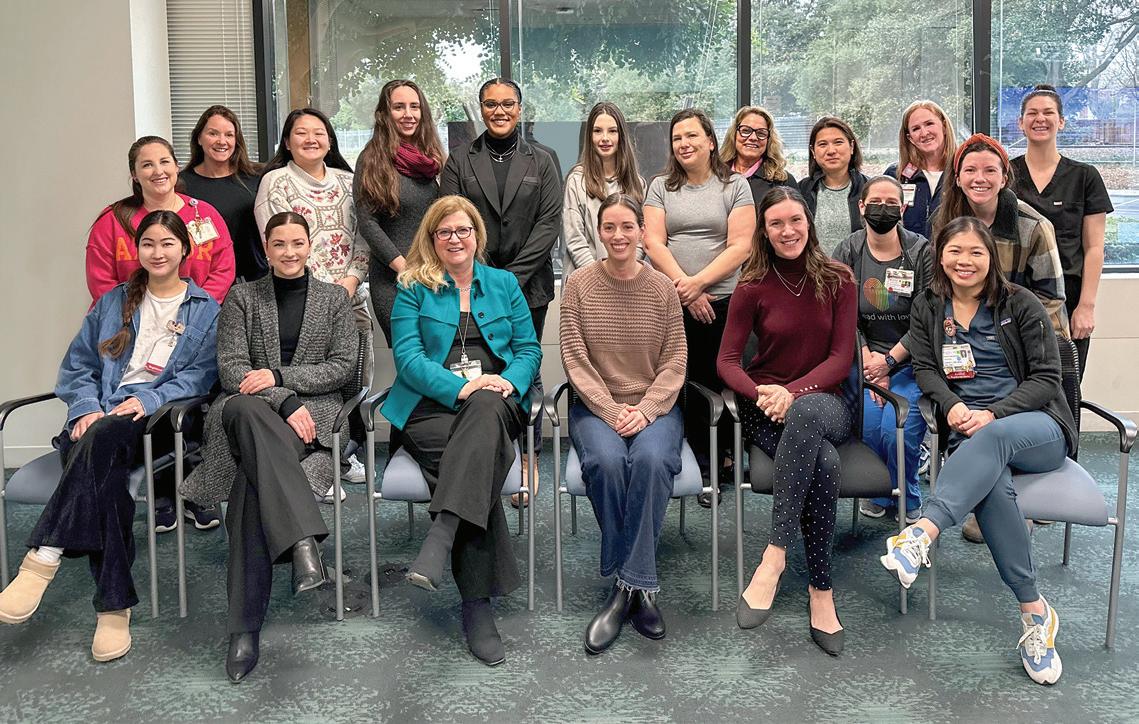
When Nailah “Zoi” Cox, RN, first witnessed the delivery of a new life, it changed her own. “I remember standing there for a two-hour C-section, and while they’re pulling the baby out, I’m thinking, ‘This is the greatest thing ever. I need to be a part of this,’” Zoi said.
As a nurse in the maternity unit, Zoi understands the significant impact of her work on health outcomes, particularly for Black mothers. While there is increasing awareness and alarm regarding the racial disparity in maternal healthcare, where Black women are three times more likely to die from pregnancy than white women, there remains a dearth of Black nurses.
“It’s not like there’s a different language, but culturally there’s a different understanding,” Zoi said. “They know I understand certain things, that I’m not going to question certain things. I can see the weight being lifted off my patient.”
In the time since our initial interview, Zoi has transitioned to a new role: Assistant Patient Care Manager in Maternity. “Leadership has been a constant in my life since my undergraduate years,” she said. “After embracing the role of motherhood, I found myself drawn to further
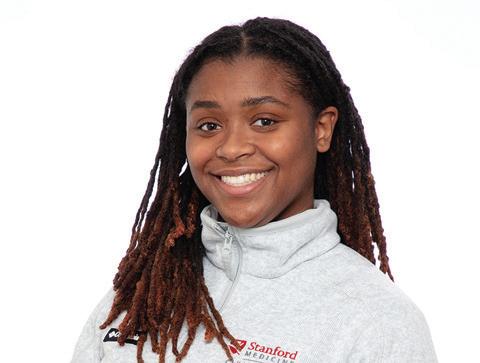
involvement. I became acutely aware of Stanford’s robust support for patient safety. While I had always known Stanford to be a leader in this regard, I was pleasantly surprised by the depth of staff involvement. It fueled my determination to be a fair leader, advocating for all equally.” To help address racial disparities, Zoi advocates for nurturing and inspiring Black children to consider careers in medicine from a young age. “I would hope that starting from middle or high school, they do see that it’s something they can do,” she said. “We need more Black nurses, and they should definitely try to go into the medical field.”
Group prenatal care at the Stanford Obstetrics Clinic provides a sense of community for new parents.
In February 2023, Stanford Obstetrics (OB) launched CenteringPregnancy, a group prenatal care model, under the dedicated leadership of Colleen Moreno, DNP, CNM, Director of Midwife Services, Grace Greenstein, MSN, NEA-BC, OB Clinic Manager, and Jacqueline De La Cruz, Assistant Clinic Manager. The initiation and successful implementation of
CenteringPregnancy, a transformative clinical approach, has redefined prenatal care and maternal support at Stanford Children’s.
A Paradigm Shift in Maternity Care
CenteringPregnancy recognizes that health care extends beyond clinical care and addresses the
Continues on page 22
Nailah “Zoi” Cox, MSN, RN, RNC-MNN, CPSTCenteringPregnancy … continued from page 21
holistic needs of pregnant individuals, offering a refreshing alternative to traditional one-on-one health care encounters. The program gathers together pregnant individuals with similar due dates in a supportive and empowering environment that fosters community, while also providing comprehensive prenatal care from our expert obstetric clinicians. This evidence-based approach improves clinical outcomes while innately creating a lifelong community of support for all participants. Session topics include everything from newborn care and the discomforts of pregnancy to presentations from experts in mental health, pediatrics, and lactation. The program also offers a session specifically tailored to that particular group’s unique needs.
• Enhanced Patient Satisfaction: Pregnant individuals have expressed high levels of satisfaction with the program, citing increased confidence, peer support, and access to educational resources as key factors.
• Cultural Competency: CenteringPregnancy provides culturally sensitive care, respecting the diverse backgrounds and needs of patients.
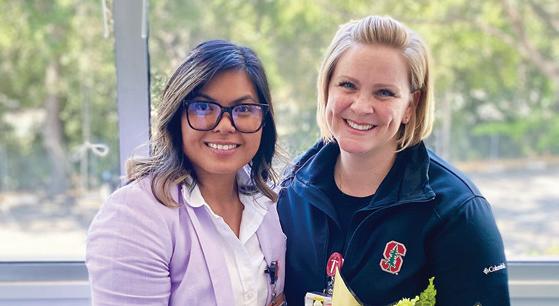
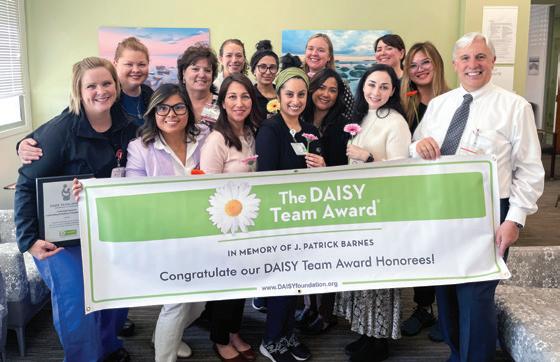
• Professional Growth: The program provides nursing staff with opportunities for professional development and the acquisition of new skills.
• Community Building: CenteringPregnancy has fostered a sense of community among participants, helping them build lasting friendships and support networks.
• DAISY Team Award: In recognition of the amazing accomplishments of the CenteringPregnancy program, the OB clinic team received a DAISY Team Award in May 2023.
The initiation and implementation of CenteringPregnancy is a testament to the power of nursing innovation and collaboration. This groundbreaking program has transformed the way Stanford Obstetrics cares for pregnant individuals, resulting in improved clinical outcomes, enhanced patient satisfaction, and a stronger sense of community. CenteringPregnancy exemplifies the profound impact that nursing professionals can have on health care.
Having your child admitted to the PICU can be a stressful experience for any parent, and being unable to communicate with the health care team taking care of your child can add additional stress to an already challenging situation. However, while 30% of our PICU patients have caregivers whose primary or preferred language is a language other than English (LOE), they often faced barriers such as inadequate use of in-person interpreters during inpatient rounds, use of accompanying family members for interpretation, and lack of identification of language preferences. This resulted in family frustrations, delayed care, and poor patient experiences. The PICU sought an intervention to offer improved continuity of care, accessibility, flexibility, and advocacy for LOE families in this high-acuity unit.
UPRISE-LOE is a process embedded into daily huddles and workflows to highlight patients/ families needing communication in languages other than English. The PICU identifies the family’s preferred language for medical discussions and coordinates in-person interpreters to offer this language-concordant care. Languageconcordant care refers to when a patient/family and provider can communicate in the same language directly, such as through the use of an interpreter. Since Spanish is the most common LOE in our area, the PICU has a designated unit-based Spanish interpreter who is present between 9:00 a.m. and 1:00 p.m. to facilitate
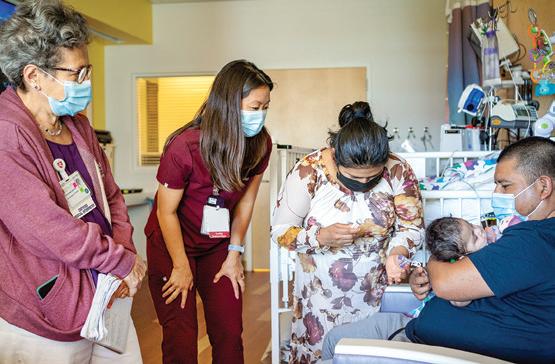
Spanish-speaking families taking part in rounds. Upon admission, nursing staff assess patient language preferences and preferred modality for updates. Available interpretation modalities include in-person, telephone, or video and are available 24 hours a day, 7 days a week, 365 days a year. Admitted families whose preferred language is any one of the PICU’s top four LOEs (Spanish, Chinese, Vietnamese, and Tagalog) receive a Welcome to the PICU pamphlet and communication cards in their preferred language to assist with activities such as calling the unit or obtaining things such as water, food, and toothbrushes. We have also created dashboards to monitor our success at providing at least one in-person medical update to our Spanish-speaking families each day. The dashboards are updated daily and shared with our PICU faculty and staff to continuously
Stanford Medicine Children’s Health is deeply committed to addressing communication inequities that affect our most vulnerable populations. To reduce communication inequities, the Pediatric Intensive Care Unit (PICU) at Stanford Children’s partnered with Interpreter Services to launch Unit-Based Pathways to Reduce Inequities for families speaking a language other than English (UPRISE-LOE). Continues
bring awareness to crucial points where languageconcordant care is necessary. In the months since this intervention was initiated, we have seen our Overall In-Person Medical Interpreter Utilization Rate steadily increase to an average of around 85%. We can also see the impact of this initiative in the feedback we receive from families and staff. A family member of a child who had recently been transferred from an outside facility shared, “For the first time, I feel like I actually know what’s happening with my child.” A bedside nurse also noted that a patient she was caring for who spoke an LOE was much more interactive when utilizing an in-person interpreter, as opposed to the interpreter iPad.
The UPRISE-LOE initiative promotes positive therapeutic alliances between families and staff. Language-concordant communication is essential to delivering safe, high-quality care for all patients/ families who speak a language other than English.
To learn more, please contact Jennie Magana-Soto, MSN, RN, CNS, jmagana@stanfordchildrens.org.
Additional UPRISE-LOE members include Felice Su, MD; Sunny Anand, MD; and Angelica Villagran de Gonzales.
“For the first time, I feel like I actually know what’s happening with my child.”
—PICU Parent
Parent-to-Parent mentors prove an invaluable resource in supporting inpatient education.
Fall prevention is an annual quality goal and one of the top priorities for the organization. After noticing an increase in the house-wide fall rate between January and March 2023 to above the Solutions for Patient Safety (SPS) benchmark of 0.8, the organization focused on identifying causes and interventions to decrease the fall rate.
In April, an interprofessional team worked to identify root causes of falls in the organization. This deep dive helped analyze, standardize, and manage diverse health data types, providing the organization with better decision-making insights. To ensure a comprehensive and inclusive approach to fall prevention efforts, Mark Zapata, MS-CPD, BSN, RN, Nursing Quality Management Coordinator, collaborated with clinical nurse specialists, unit leadership, and frontline staff to both share his findings and gather recommendations.
Based on the identified root causes, the organization was able to launch several initiatives, including quarterly newsletters and screensavers to remind staff of fall prevention best practices. In addition, Kristine Taylor, DNP, MPH, RN, CENP, Executive Director of the Center for Professional
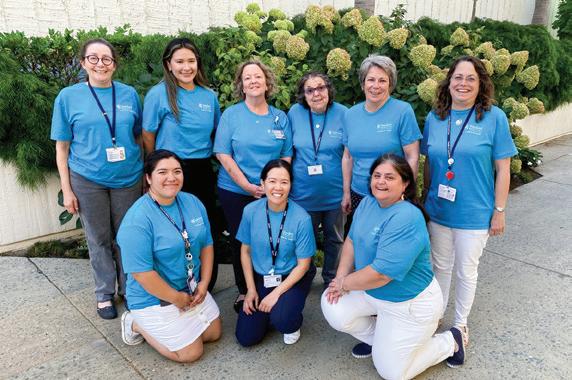
Excellence & Inquiry, and Jenny Shaffer, DNP, CNS, ACCNS-P, Manager of the Office of Patient/ Family Education and Health Literacy, collaborated with the Family Centered Care Department’s Parent-to-Parent (P2P) Mentors to ensure that patient families were provided with information on fall prevention topics. P2P mentors are specially trained parents of children with chronic/complex conditions who provide training and support to inpatient families. This initiative, which includes Spanish-speaking mentors, was vital in addressing common denominators and themes in real time. Mark notified the P2P mentors whenever a new fall event was reported so that they could educate the patient and family, circling back, even if they had already provided falls education to that family.
In June, the organization reported zero fall events, and the rate has remained below the SPS benchmark since April 2023. To sustain this effort, the team continues to review fall events monthly; provide continuous education for patients, families, and staff; and adapt their fall prevention strategies to align with the latest research and data trends.
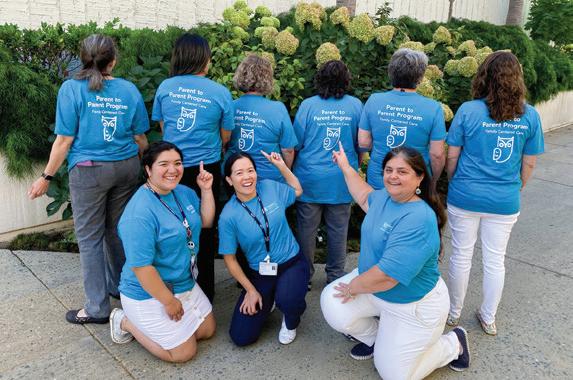
I will never forget the day we met. It may have been the worst day in your parents’ lives, and not just a regular day for me as the neonatal transport specialist on duty.
I was on call from home and about to sit down to dinner with my family. My cell phone rang, and I knew it was urgent. Oscar in the dispatch center only calls me when he really needs me to hurry. Oscar gave me a name, weight, location, and diagnosis of respiratory failure of a 4-day old. He also said to race in. During the 10-minute drive, I made phone calls to coordinate the team and spoke with Dr. Lisa Bain, the physician in charge of the transport. We made a plan based on the outside hospital’s physician report. There was no time to get a nurse-to-nurse report—even Dr. Bain said to hurry, so hurry I did. Your dad and grandparents were present in the Emergency Department (ED) quietly concerned for you. That was when I learned that your dad did CPR on you at home while 911 was being called. Your dad saved your life! I just helped get you to the people who could help you more.
I knew things were bad the moment I walked into the room. The plan that I made with my team in the ambulance heading down to the ED with lights and sirens screaming immediately went out the window … time for plans B, C, and D. You were fighting to live, and I needed to hurry up and help you. There were at least 15 people in the ED bay scurrying about. Out of the corner of my eye I saw a familiar face. It was Jennifer, a Neonatal Intensive Care Unit (NICU) nurse I used to work with at Stanford Children’s. A sense of calm came over me as things escalated in the room and the physician in charge handed the case over to me and the team. I requested that he stay present—this was going to be an all-hands-on-deck transport. The fear was palpable in the room. I asked all nonessential people to please vacate the space.
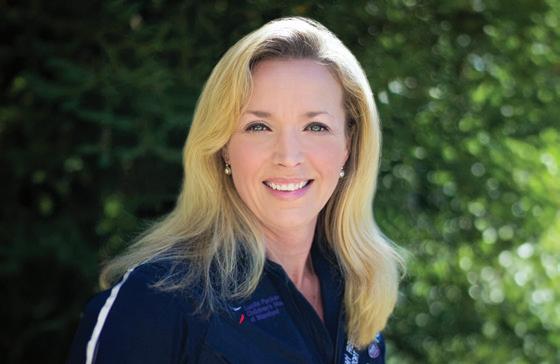 Amy Freiha, BSN-RN, MSN-NNP-BC
Amy Freiha, BSN-RN, MSN-NNP-BC
My respiratory therapist (RT) was attempting to follow the original plan and quickly realized that we needed to intervene faster. We had already increased to 100% oxygen the minute we entered the room. I instructed him to start hand-bagging while I prepared for rapid sequence intubation. The ED staff already had medication and equipment out, so I gave them my doses for the drugs, and we began. I stood there stroking your small and soft head, whispering that everything was going to be OK soon. I begged you to hang in there and keep fighting with me. Your dad was standing to my right, watching every move I made, refusing to leave your side. Your small body succumbed to the medication quickly, and I easily intubated you. X-ray was waiting for a STAT film— within minutes you had a confirmed secure airway.
Next, we needed to get an arterial blood gas to see how much faster I needed to move and what kind of ventilator settings you needed. During this time, I had the emergency medical technicians (EMTs)
Continues on page 27
A Day in the Life … continued from page 26
documenting vital signs and every intervention we did. I also instructed the EMTs to position the gurney and find wall gases and power. My nurse was drawing up volume; Jennifer was pulling down your IV fluids. I prepared to do the stick … I needed a number to report to Dr. Bain, although I already knew in my gut which way your care was headed. Your pulse was like a feather tickle—faint, intermittent, nonexistent, then tickle again. I got nothing the first stick, refused to walk away, and assessed for the artery again. You gave me a pulse. I marked your wrist with my fingernail because it was gone within a second. I got it, just enough to run the gas, the numbers what I expected. The phone call to Dr. Bain was detailed yet brief. She knew too.
The plan that I made with my team in the ambulance heading down to the ED with lights and sirens screaming immediately went out the window … time for plans B, C, and D. You were fighting to live, and I needed to hurry up and help you.
I turned to my team and told them the results. Everyone knew to hustle. As everyone broke off into their tasks, I turned to your dad, still standing by your side. I threw the Book of Transport at him: consent, blood transfusion, central lines necessity, the good, the bad, the ugly, the urgency, and then the ECMO consent. I made sure he was not going to be driving. I was worried about his safety after all he had just seen and done to save you. Your grandparents said they would make sure he arrived safely, and we discussed how to get your mother into the hospital while ill. I said I would try to take care of it all, but I needed to move. I needed to get you to the NICU. I tried my best to give your family comfort and hope during a very chaotic and unsure time. This was an
extremely difficult task. I wear my emotions on my sleeve; my face cannot lie. Your family heard me directing with authority and attention for time.
As soon as we got in the ambulance, we were off with lights and sirens back to the nursery. I realized quickly that your status was tenuous at best, and I needed better access to you. I popped the plexiglass lid off the isolette (never done that before), made sure your seat belt was tight, and covered your blanket-swaddled body with a heat pack to keep you warm. Every few minutes I assessed your breath sounds, suctioned yellow fluid out of the back of your nose, and watched every hand-bagged breath my RT delivered. My nurse reported vital signs anytime I heard an alarm. I stood over you the entire ride back, 65 mph down the freeway … nearly the longest 30 minutes of my life. Dr. Bain asked how she could support me better when I told her I was scared. I asked her to pray for us all, but mostly you! Everyone was ready for our arrival. We made it, you made it, you fought with me! I signed out to the team and stepped out of the room. There was your mom, sick and weary. I made a direct line for the manager’s office and pleaded with her to make sure she had access to you. I needed to know that we did all that we could to give you as much time together as possible. I promised that your mom would put on all the personal protective equipment mandated if it allowed her to be by your side. My manager agreed. I dragged myself to the office to start the tasks of charting, billing, and restocking all the items from transport. I made sure to debrief with my team on how the run went. We all just smiled and wiped our brows. I will remember every breath, every movement, every heartbeat (yours and mine combined) that happened during your transport. You survived ECMO and 60+ days in the NICU/ICN and are still exceeding everyone’s expectations. You are a strong-willed baby. That will translate throughout your childhood. Just know how much your parents love you and worried for you. You are safe now, in their loving arms!
The Center for Professional Excellence & Inquiry expands their simulation space.
In October 2023, the Center for Professional Excellence & Inquiry (CPE&I) relocated their simulation program to a new 4,900-square-foot location, yet another step in its journey to creating a premier simulation space for Stanford Medicine Children’s Health staff and the community.
Prior to the move, the simulation space consisted of just one room, with a tiny control room from which to manage and oversee simulation exercises. The new space features a state-of-the-art control room; two dedicated Neonatal Resuscitation Program (NRP) training spaces; four dedicated Pediatric Advanced Life Support (PALS) training spaces; a combination PALS/Ambulatory training space; and three training spaces with high-fidelity manikins for obstetrics, neonatal, and pediatric simulations. The space also includes three conference rooms with AV and debriefing capabilities and a large open skill station area. In total, the team can host up to three simultaneous simulation trainings at one time.
With the expansion and equipment upgrade, CPE&I is poised to support increasing numbers
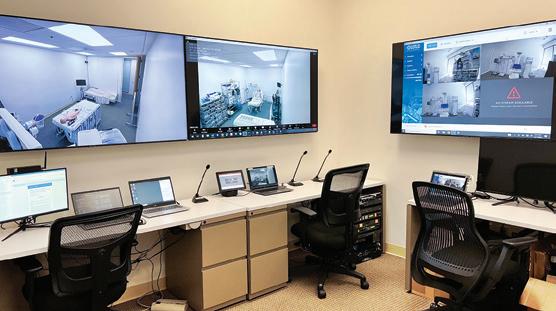
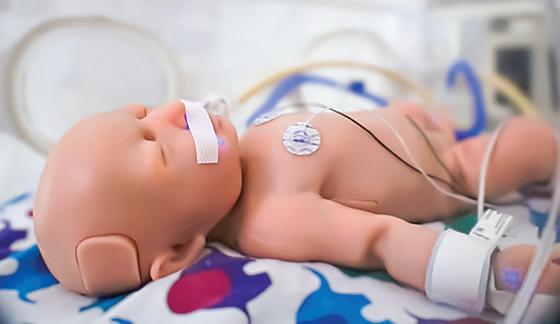
of learners while extending training offerings beyond Stanford Children’s staff to the community at large. Future opportunities include hosting simulation symposiums to introduce new equipment, expanding NRP offerings, providing a training space for local medical facilities that do not have access to simulation spaces, incorporating virtual reality to enhance our organ procurement training, and hands-on training for families of children with tracheostomies.
Now dubbed the “Innovation Center,” the new space recognizes a focus that extends beyond simulation technology and reflects our commitment to fostering creativity, pioneering solutions, and driving forward-thinking initiatives.
The team plans to hold an Open House to officially open the new Innovation Center in early 2024.
How a multifaceted approach can make a positive impact.
Research studies have found that socioeconomic status (SES) can negatively impact pediatric heart transplant patients, with lower socioeconomic backgrounds linked to a higher risk of graft failure or poor outcomes posttransplant. In the past decade, however, there has been a significant increase in awareness about SESrelated health care inequities. In addition, advances in technology, medicine, and surgical techniques have led to significant advancements in outcomes in pediatric heart transplant patients.
Nurse Practitioner Allison Armstrong, NP, in collaboration with a group of researchers from Stanford Medicine Children’s Health—Kimberly Pyke-Grimm, NP, PhD, Seth Hollander, MD, Danton Char, MD, and Jane Liang, PhD— investigated the impact of socioeconomic status on pediatric transplant outcomes in the contemporary era at the organization.
The team completed a retrospective chart review of 176 pediatric patients who underwent their first heart transplant surgery between 2013 and 2021 at the hospital. In contrast with previous research, their study found no significant differences in graft failure, rejection rates, or hospitalization rates associated with socioeconomic variables.
The lack of association between SES and poor pediatric heart transplant outcomes at our organization may be partially attributed to medical and psychosocial advancements in transplant therapies. Addressing the diverse mechanisms underlying health disparities requires a multifaceted approach, including increased access to resources and education.
The pediatric cardiac transplant team at Stanford Children’s has developed posttransplant protocols specifically aimed at addressing disparities
Their study found no significant differences in graft failure, rejection rates, or hospitalization rates associated with socioeconomic variables.
and reducing barriers. For instance, patients living more than 30 miles from the hospital are required to reside in local housing for a designated period (e.g., three months) after heart transplantation, with many opting to stay at a local Ronald McDonald House, a free resource for families that provides accommodation, meals, and transportation to follow-up appointments. Furthermore, the transplant team implements a structured education curriculum throughout the pre- and posttransplant period specifically tailored to patients and families to address health literacy. Families receive a comprehensive binder in their primary language detailing surveillance monitoring, medications, and other pertinent information. Nurse practitioners meet with families during hospitalization to review the transplant binder, with more frequent meetings scheduled for patients identified as having lower health literacy rates. By offering these resources during the vulnerable posttransplant period, our center aims to mitigate barriers that may disproportionately affect families with lower socioeconomic status.
This project was supported by the Nursing Research Fellowship program. See page 30 for more information. For details about this study, see Armstrong, A., Liang, J. W., Char, D., Hollander, S. A., & Pyke-Grimm, K. A. (2024). The effect of socioeconomic status on pediatric heart transplant outcomes at a single institution between 2013 and 2022. Pediatric Transplantation, 28:e14695.
The goal of the Nursing Research Fellowship Program, established in 2021 by the Department of Nursing Research and Evidence-Based Practice (EBP), is for nurses to develop a clinically focused research proposal, to conduct a study during the 24-month fellowship period, and to disseminate the study findings by way of presentations at conferences and through publication.
Past Research Fellows include Allison Armstrong, NP, who analyzed the impact of socioeconomic status on pediatric heart transplant outcomes (see story on page 29).
Research Fellow 2022–2024
Allison Nolen, MSN, RN, CNL, CPN (Bass Infusion Center), Determining the Efficacy of Essential Oil Aromatherapy on Children Undergoing Port Access
EBP Fellow 2023–2024
Jackson Moorman, MSN, RN, CNL, PHN (PCU300), Transforming Care: Examining the Effect of Trans Affirmative Training for Nurse Advocates on Inclusive Care Delivery at the Bedside
The Outstanding With Literature (OWL) Award recognizes Stanford Children’s nurses and advanced practice providers (APPs) who have published their research and evidence-based practice in a book or peer-reviewed journal or presented at a local or national conference. Italicized names indicate the recognized nurses and APPs.
Podium Presentations
Alvarez, K., Steele, K., Bunnell, B., Stroud, M., Chan, K., & Chao, S. (2023). Improving the road to survivorship: Early mental health screening in pediatric trauma patients. Trauma Quality Improvement Program (TQIP) Annual Conference, Louisville, KY.
Alvarez, K., Steele, K., Bunnell, B., Stroud, M., Chan, K., & Chao, S. (2023). Integrating mental health screening in pediatric trauma patients: A quality improvement initiative Western Pediatric Trauma Conference, Carlsbad, CA.
Chan, C., & Nasr, A. (2023). Usability and utility of human immunodeficiency virus pre-exposure prophylaxis clinical decision
support to increase knowledge and pre-exposure prophylaxis initiations among pediatric providers. Clinical Informatics Conference, Chicago, IL.
Correa, J., Russell, J., Sullivan, J., & Van Eijk, M. (2023). Designing with input of frontline workers. Health Care and Facilities Symposium and Expo, Charlotte, NC.
Davis, J., Gonzalez, C., Kirby, K., Shubs, L., & Sisk, T. (2023). Preparing for Fontan surgery. Fontan Outcomes Network (FON) & National Pediatric Cardiology Quality Improvement Collaborative (NPC-QIC) Fall Learning Session, Chicago, IL.
Dyer, A., Lin, H., & Nolan, M. (2023). Clean the air! The time is now. Yankee Alliance Conference, Bolton Landing, NY.
Continues on page 31
Outstanding With … continued from page 30
Freccero, A., Scala, M., & Nasr, A. (2023). Body wrap devices and their effects on skin-to-skin care in the neonatal population: A pilot study. Healthcare Con, Stanford, CA.
Lahey, M., & Mueller, C. (2023). Structured interviews help reveal patient and parent perspectives on peristeen enema systems for anorectal malformations. 14th Annual European Pediatric Colorectal and Pelvic Reconstruction Meeting, Milan, Italy.
Lee, S., Manipon, C., & Tong, J. (2023). Seeing is believing: A focus on POCUS. Academy of Neonatal Nursing, Las Vegas, NV.
Lee, T., Vik, J., & Shu, E. (2023). How to get started in ambulatory safety. SPS Ambulatory Foundations Network Virtual Conference.
Leung, A., & Li, E. (2023). Empowering clinicians to become health literacy leaders. ANCC Magnet Conference, Chicago, IL.
Lin, H. (2023). Care of the patient with COVID. Taiwanese Nurse Practitioner Association, Taipei, Taiwan.
Lin, H. (2023). The heart of nursing: A global perspective on surgical missions. Periop ConneCT, New Haven, CT.
Lu, B., Nolen, A., Koppolu, R., & Pyke-Grimm, K. (2023). Implementing an evidence-based practice education course for staff: A children’s hospital experience. North Bay’s Health Evidence-Based Practice and Research Conference, Green Valley, CA.
Mandac, C., Marshall, A., & Nasr, A. (2023). Age at liver transplant and the effect on quality of life, anxiety, and depression in adolescent patients. Healthcare Con, Stanford, CA.
Mooney Doyle, K., Santos, M., Chesla, K., Johansson, A., Uveges, M., Voltelen, B., & Pyke-Grimm, K. (2023). Ethics in family education, practice, research, and policy: A survey of IFNA members. 16th International Family Nursing Conference, Dublin, Ireland.
Mourrain, S. (2023). Leadership at the intersection of technology and nursing. 48th Annual National Association of Hispanic Nurses Conference, Portland, OR. Myrie, J., Wong, C., Talley, E., Goldstein-Fuchs, D.J., & Vazquez, E. (2023). Social determinants of health within a pediatric dialysis unit: A novel quality improvement project assessing food insecurity. Annual Dialysis Conference, Kansas City, MO.
Nasr, A. (2023). Understanding parental and adolescent perspectives on live liver donation. 34th Sigma Theta Tau International Nursing Research Congress, Abu Dhabi, United Arab Emirates.
Pederson, S. (2023). Anaphylaxis in the ambulatory clinic. American Society of Allergy Nurses Annual Conference, Seaside, OR.
Pincus, E., Wymer, J., Yau, S., Lin, H., Dennis, E., & Basora, E. (2023). Fostering our future nurses through a culture of engagement. Association of Perioperative Registered Nurses Surgical Conference & Expo, San Antonio, TX.
Pyke-Grimm, K. (2023). Bioethics at the bedside. Pediatric Oncology Group of Ontario (POGO), Toronto, Canada.
Pyke-Grimm, K. & Gupta, A. (2023). Decision making in adolescents and young adults with cancer: Considerations for clinicians. Pediatric Oncology Group of Ontario (POGO), Toronto, Canada.
Pyke-Grimm, K., Lough, M., & Davis, K. (2023). Is my project research, EBP & QI: Why does it matter. Healthcare Con, Stanford, CA.
Schulz, G., Pyke-Grimm, K., & Kelly, K.P. (2023). Child and adolescent self-reported outcomes related to their involvement in their cancer communication: Results from a systematic review of qualitative research. 16th International Family Nursing Conference, Dublin, Ireland.
Continues on page 32
Outstanding With … continued from page 31
Simon, P., Nasr, A., & Pyke-Grimm, K. (2023). Using a mixed methods study to assess the needs of AYAs receiving cancer treatment. Healthcare Con, Stanford, CA.
Smedley, L. (2023). “We” always wins in the “us versus them” competition. Synova NICU Leadership Forum, Tucson, AZ.
Suplit, B. (2023). Challenging behavior: What you need to know for your patients, the team and yourself. AACN NTI, Philadelphia, PA.
Vasquez, Y., Sanders, L., Beale., H., Geoffrey, L., Kephart, E., Learned, K., Thomson, D., Peralez, J., Li, A., Huang, M., Pyke-Grimm, K., Salama, S., Haussler, D., Bjork, I., Vaske O., & Spunt, S. (2023). Analysis of RNA expression identifies druggable targets in pediatric patients with recurrent/refractory or rare solid tumors. Annual Cancer Genomics Consortium (CGC), St. Louis, MO.
Williams, M., Kent, L., Fisher, J., Pinner, L., Callard, E., & Pyke-Grimm, K. (2023). Initiation of palliative care services early in patients undergoing hematopoietic stem cell transplant. Healthcare Con, Stanford, CA.
Williams, M., Kent, L., Pinner, L., Callard, E., Fisher, J., & Pyke-Grimm, K. (2023). Early integration of palliative care consults in pediatric stem cell transplant patients. American Society for Transplantation and Cellular Therapy (ASCTC), Orlando, FL.
Wintch, S. (2023). Ask the nursing expert panel. Society for Pediatric Sedation Conference, Chicago, IL.
Wolfe, K., Cousino, M., & Kirby, K. (2023). A framework for neurodevelopmental impact in the acute care cardiology setting—on a low-cost budget. The Pediatric Acute Care Cardiology Collaborative (PAC3) Fall Virtual Conference.
Poster Presentations
Armstrong, A., Liang, J.W., Char, D., Hollander, S.A., & Pyke-Grimm, K. (2023). The effect of socioeconomic status on pediatric heart transplant outcomes at a single institution between 2013–2022. MCHRI Symposium.
Baggese, L., Sell, G., Pena, V.I., Ferrari, S., & Blair, R. (2023). Plan, do, check, act (PDCA) to improve ambulatory internal process workflows and clinical practice: A multidisciplinary team approach. Lean Healthcare Conference.
Bui, J.K., Johnson, A.N., Neeley, A., Martin-Spriggs, J., Jacobs, L., Liu, L., Admani, S., & Teng, J.M.C. (2023). Home education series by experts on pediatric atopic dermatitis. Society for Pediatric Dermatology’s Annual Meeting.
Chan, C., & Nasr, A. (2023). Health information services support through a work stoppage in an academic health system. American Medical Informatics Association.
Chang, J., Lin, E., Le, D.P., Arroliga, J., Crowe, S., Williams, Z., Dahlen, A., Blackmon, S., & Nasr, A. (2023). Maternity care practices for mothers with SARS-COV-2 and the feeding practices of their infants. 10th International Conference on Nutrition & Growth.
D’Anjou, L., Chang, N., Sperber, A., Rasmussen, L., & Pyke-Grimm, K., (2023). Brighter days in the PICU: Implementing a nurse-driven lighting protocol. AANN Neuroscience Nursing Annual Conference.
Goldstein-Fuchs, D., Paquia, V., Espiritu, M., & Wong, C. (2023). Spurious hyperphosphatemia: Quality initiative to decrease blood loss and streamline resources in an outpatient pediatric hemodialysis unit. Annual Dialysis Conference.
Kent, L., Williams, M., Pinner, L., Callard, E., Fisher, J., & Pyke-Grimm, K. (2023). Initiation of palliative care services early in stem cell transplant course. WIN Conference.
Continues on page 33
Kirby, K., Maida, K., Chen, S., & Shah, A. (2023). Implementation of developmental tool kit for single ventricle home monitoring infants: A multidisciplinary approach. 8th World Congress of Pediatric Cardiology and Cardiac Surgery.
Kirby, K., Catton, K., Aufdermauer, A., Bell, L., Chen, S., & Shah, A. (2023). Overcoming barriers to successful outpatient feeding for single ventricle interstage patients: The nutrition bundle quality improvement intervention. 8th World Congress of Pediatric Cardiology and Cardiac Surgery.
Lin, A., Wang, T., Wintch, S., Basravi, S., Mediratta, R., Chi, K., & Fehr, J. (2023). Working towards less than one; A collaboration between anesthesia and the sedation team to decrease unsuccessful sedations. Society for Pediatric Sedation.
Lin, H. (2023). Evolution of the nurse practitioner in a surgical specialty. Asian and Pacific Congress for Nurse Practitioners.
Lin, H. (2023). Innovations in the collaborative management of newborn sleep apnea. Asian and Pacific Congress for Nurse Practitioners.
Magana-Soto, J., Rey Ardila, D., Ruiz, M.O., Bonillas, A., Persoglia-Bell, M., Su, F., & Anand, K.J.S. (2023). Unit-based pathways to reduce inequities for families with limited English proficiency: UPRISE-LEP Study. Healthcare Con.
Margallo, D. (2023). Showcasing NPD practitioners’ value using a digital competency management system. ANPD Annual Convention.
Mariano, K., & Weiss, S.J. (2023). Infant emotionality is associated with more severe symptoms of depression at 6 months postpartum. American Academy of Pediatrics.
Marquiss, K., Rodriguez, J., Ciraulo, L., Casazza, M., Chang, N., & Sperber, A. (2023). Improving pediatric neurocritical care nurse competency through interactive learning. AANN Neuroscience Nursing Annual Conference.
Moore, A.K., Halamek, L.P., Fuerch, J.H., Galindo, R.B., Sequoia, J.A., & Yamada, N.K. (2023). Process improvement through reviewing recorded neonatal resuscitations. Neonatal Resuscitation Symposium.
Neeley, A., Bui, J.K., Johnson, A.N., Martin Spriggs, J., Jacobs, L., Liu, L., Admani, S., & Teng, J.M.C. (2023). Eczema bootcamp: Home education series by experts on pediatric atopic dermatitis. Karsek Lecture.
Orlandi-Maurer, P., Dalusag, K., Chan, H., Claure, R., Pinchon, C., & Balakrishnan, K. (2023). Emergent case classification—timeliness to the OR-report, audit, and QI. ACS National Quality and Safety Conference.
Kelly, K.P., Pyke-Grimm, K., & Schulz, G. (2023). Prechool-aged child’s self-reported cancer communication preferences. Research, Education and Innovation Week.
Kelly, K.P., Pyke-Grimm, K., & Schulz, G. (2023). Using a qualitative systematic review to develop practice recommendations for engaging children and adolescents with cancer less than 18 years in their treatment decision making. National Children’s Hospital Research, Education and Innovation Week.
Pyke-Grimm, K., & Koppolu, R. (2023). Introduction to evidence-based practice course: An opportunity for staff and leader engagement. Healthcare Con.
Rodriguez, J., Ciraulo, L., & Chang, N. (2023). Light and sound levels in a pediatric neuro ICU: Are we missing the mark? AANN Neuroscience Nursing Annual Conference.
Continues on page 34
Shaffer, J., Li, E., Leung, A., Jahanbakhsh, M., Lin, E., Brown, T., Rogers, S., Dykes, N., & Olmos, M. (2023). Closing the knowledge gap: Improving health outcomes one team member at a time. Healthcare Con. Squires, S., Kipps, A., Gamuciello, S., Mak, K., Chen, X., Spengler, M., Escobar, V., Gillar, W., Taylor, K., Nigh, A., Glassey, A., & Chadwick, W. (2023). A quality improvement initiative to improve discharge medication education on a pediatric cardiology unit. 14th Annual Pediatrics Research Retreat. Tong, J., Manipon, C., & Ly, M., (2023). But first, POCUS: Using point of care ultrasound in your everyday practice. National Association of Neonatal Nurses Annual Conference. Wintch, S., & Olson, T. (2023). Living in a protocol world. Society for Pediatric Sedation.
Publications in a Book or Peer-Reviewed Journal
Abramsky, R., Alkhadem, Z., Alsup, S., Anwar, T., Arroyo, M., … Glennon, C., … Zengi, I. (2023). Proceedings of the 14th International Newborn Brain Conference: Long-term outcome studies, developmental care, palliative care, ethical dilemmas, and challenging clinical scenarios in neonatal neurology. Journal of Neonatal-Perinatal Medicine. 16(s1): S103–S118.
Benedetti, D.J., Marron, J.M., Thomas, S.M., Caruso Brown, A.E., Pyke-Grimm, K.A., Johnson, L.M., Kodish, E., Unguru, Y. (2023). Words matter. Journal of Clinical Oncology, 41(3), 706–707.
Benedetti, D.J., Marron, J.M., Thomas, S.M., Caruso Brown, A.E., Pyke-Grimm, K.A., Johnson, L.M., Unguru, Y., & Kodish, E. (2023). The role of ethicists in pediatric hematology/ oncology: Current status and future needs. Pediatric Blood and Cancer, 70(2), e30132.
Camp, C.E., Chan, C.T., & Saberi, P. (2023). Young adult perspectives on sex, dating, and PrEP use during the pandemic and improving the future of PrEP care. AIDS and Behavior, 27(7), 2430–2438.
Chan, C.T. (2023). Association between body mass index and posterior spine fusion among patients with adolescent idiopathic scoliosis. PLOS One, 18(5), e0286001.
Chau, A., Albuliwi, B., Maskatia, S., Martin, E., & Ryan, K. (2023). 153: Favorable vessel patency following carotid artery reconstruction after ECMO in children with heart disease. American Society for Artificial Internal Organs Journal, 69 (Supplement 3), 59.
Freccero, A., Scala, M., McLeod, K. A., Donahue, B., Webb, M., Briggs, M., Najm, I., Sinha, M., Santagata, L., Dahlen, A., & Nasr, A. (2023) The safety of body wraps on skin-to-skin care in the neonatal population: A pilot study. Advances in Neonatal Care. Epub 2023 Dec 21.
Godin, M.R., & Nasr, A.S. (2023). Assessing the impact of a new pediatric healthcare facility on medication administration: A human factors approach. Journal of Nursing Administration, 53(6), 331–336.
Goldstein-Fuchs, D.J., & Beto, J. (2023). Cardiovascular disease and kidney disease. In J. Gonyea & S. Phillips (Eds.), Clinical Guide to Nutrition Care in Kidney Disease (3rd ed), Academy of Nutrition & Dietetics.
Hollander, S.A., Pyke-Grimm, K.A., Shezad, M.F., Zafar, F., Cousino, M.K., Feudtner, C., & Char, D.S. (2023). End-of-life in pediatric patients supported by ventricular assist devices: A network database cohort study. Pediatric Critical Care Medicine, 24(1), 41–50.
Kirby, K., Noori, H., Lombardi-Lytle, S., Scala, M., Beidelman, M., Dubner, S., & Ryan, K. (2023). Implementation of a dedicated cardiac neurodevelopmental program. Cardiology in the Young, 33(7), S1240.
Outstanding With … continued from page 34
Klepper, M., Deng, A., Sherman, A.D.F., Lawrence, C., Ling, C., Talbert, S., & Bower, K.M. (2023). LGBTQI+ representation in pre-licensure nursing textbooks: A qualitative descriptive analysis. Nurse Education Today, 127, 105858.
Koppolu, R., Nandwani, M., Navoa, J., & Kuriakose, C. (2023). Advanced practice provider onboarding: An academic teaching institution’s experience. Journal of Nursing Administration, 53(6), 326–330.
Levoy, E., Sperber, A., Poon, D., Casazza, M., Vargas, J., Yang, S., Grant, G., Singer, S., & Srinivas, N. (2023). A multifaceted intervention to improve teamwork on an inpatient pediatric neurosurgery service. Joint Commission Journal on Quality and Patient Safety, 50(2), 104–115.
Mills, M., Algaze, C., Journel, C., Suarez, G., Lechich, K., Kwiatkowski, M.D., Schmidt, A.R., & Collins, R.T. (2023). Intensive care unit analgosedation after cardiac surgery in children with Williams syndrome: A matched case-control study. Pediatric Cardiology, (45)1, 107–113.
Ma, M., Sandberg, J., Farhadian, B., Silverman, M., Xie, Y., Thienemann, M., & Frankovich, J. (2023). Arthritis in children with psychiatric deteriorations: A case series. Developmental Neuroscience, 45(6), 325–334.
Quiñónez, Z.A., Pyke-Grimm, K.A., & Char, D. (2023). In response. Anesthesia and Analgesic, 136(6), e29–e30.
Rivera, N., Nguyen, K., Kalami, V., Qin, F., Mathur, M.B., Blankenburg, R., & Yeh A.M. (2023). A specific carbohydrate diet virtual teaching kitchen curriculum promotes knowledge and confidence in caregivers of pediatric patients with inflammatory bowel disease. Nutrients, 15(18), 3999.
Simon, P.J., Pyke-Grimm, K.A., & Nasr, A.S. (2023). Assessing the needs of adolescents and young adults receiving cancer treatment: A mixed methods study. Journal of Adolescent and Young Adult Oncology, 12(1), 43–52.
Stroud, M. (2023). Trauma around the world. In Emergency Nurses Association (Ed.), Trauma Nurse Core Course (TNCC) Provider Manual (9th ed.) (pp. 1–11). Jones & Bartlett Learning. Stroud, M. (2023). Surface & burn trauma. In Emergency Nurses Association (Ed.), Trauma Nurse Core Course (TNCC) Provider Manual (9th ed.) (pp. 227–250). Jones & Bartlett Learning.
Taam, B., & Lim, F. (2023). Best practices in pediatric oncology pain management. American Journal of Nursing, 123(5), 52–58.
Tanafranca, A.F., & Taam, B. (2023). Authentic leadership at the bedside and beyond. In N. Rollins Gantz & T. B. Hafsteinsdóttir (Eds.), Mentoring in Nursing through Narrative Stories Across the World (pp. 345-351). Springer.
Unguru, Y., Bernhardt, M.B., Berg, S.L., Marie-Johnson, L., Pyke-Grimm, K., Woodman, C., & Fernandez, C.V. (2023). Essential medicines for childhood cancer in Europe. Lancet Oncology, 24(2), e67. Weigel, N., Hintz, S., Kaplinski, M., Barth, R., Balakrishnan, K., Panelli, D., Ma, M., & Chitkara, R. (2023). Prenatal diagnosis and postnatal management of a fetal pericardial mass. Neoreviews, 24(10), e683–e689.
